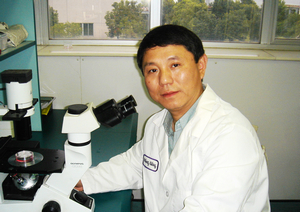 |
Wang Mingwei, M.D., Ph.D., Director,The National Center for Drug Screening &The Chinese National Compound Library; Professor, Shanghai Institute of Materia Medica, Chinese Academy of Sciences
(Image by SIMM) |
How did you decide you wanted to be a scientist?
I was trained as a surgeon in China, and in the early 1980s, came to the United States to further my education. As a physician, I was limited to only being able to help one patient at a time. By contrast, scientists involved in basic research have the ability to address fundamental questions in medicine where any breakthrough or new development can benefit hundreds, if not thousands of patients. I wanted to spend my time more efficiently by helping a larger number of people. Thus, it was with this desire that I chose to enter science and start my research career in Cambridge, UK.
What drew you to pharmacology in particular?
Pharmacology is a subject in which I believed that my clinical experience was best combined with my scientific training. By being able to use all available tools, technologies, and methodologies, one would be able to characterize a substance with biological activities, thereby discovering a drug candidate.
Tell us about a particularly exciting moment in your scientific career so far.
An exciting moment was our serendipitous discovery of a new class of non-peptidic glucagon-like peptide-1 agonists (cyclobutane derivatives, best exemplified by Boc5) with therapeutic effects on diabetic mice. This was considered a disruptive discovery by the scientific community in a difficult research field (i.e. mimicry of the actions of larger peptide for class B G-protein-coupled receptors via a small molecule approach) because our predecessors had all failed in seeking such molecules. This breakthrough took more than 4 years of relentless efforts and unwavering perseverance, with each member of my team playing an indispensablerole. As a result, I was able to take each contribution and bridge them together in a manner that led to this unexpected finding. I am proud that our work has now been reproduced by several laboratories around the world, and our innovation has also been well recognized.
You have been involved in drug discovery through academia, industry, and governmental roles. What lessons do you think the three branches can learn from each other?
I was initially involved in drug discovery in an industrial setting, and later moved back to academia. Drug discovery requires the participation of these three branches. The government institutes the rules, regulations,and laws that govern the discovery and development process. Academia is more inclined towards early-stage discovery, whereas industry has the know-how and economic resources to make a drug candidate enter the market through clinical development. However, the basic principle does not change no matter where drug discovery is conducted, because of the commonalities in this path. The only difference is the emphasis. For example, each branch may approach the same issue from different angles and use entirely different methods to resolve it, but in the end the measure of achievement remains identical. Thus, it is imperative that these three branches cooperate and coordinate with each other in a complementary manner in order to increase research efficiency and enhance the return on investment.
China has seen explosive growth in pharmaceutical development in recent years. What makes China such an attractive place for drug discovery now?
In the past three decades, China has gone through a tremendous transformation, politically, economically,and socially. With modernization of the public infrastructure, the availability of a dazzling talent pool,and enormous investment in research and development (R&D), these three aspects combined have created an unprecedented period in Chinese history in which innovation is not a luxury, but rather a necessity, in order for China to become a true world power beyond its sheer population, geographic size, and booming economy. This is the background behind China’s rise in prominence in drug discovery, whereby almost every multinational pharmaceutical company has established its own R&D mechanism there. It demonstrates the potential these companies see in China, and their willingness to participate in China’s drive towards innovation. In addition, there is a flourishing (professional and technical) service industry, including several of the largest contract research organizations across the globe, that attracts both domestic and international investors to tap into this historic opportunity.
What do you think the biggest challenge is for drug discovery in China at the moment?
China’s indiginous pharmaceutical industry continues to undergo a process of transformation from imitation to innovation. Although many professional talents are locally situated, they are mainly academics who are inexperienced in the industrial aspects of drug discovery, resulting in amateur attempts and redundancy in efforts. Furthermore, China continues to suffer from a lack of cohesive effort towards a common goal and continues to fall back onto guerilla-like entrepreneurial and self-interested pursuits. Nevertheless, this may change following implementation of the national mega R&D program in drug discovery, which will encourage more joint ventures and cooperation and will emphasize the need to benefit mankind.
What advice would you give to a young person starting a career in pharmacology today?
A pharmacologist has the unique opportunity to be able to help not only the patient but also the doctor. Therefore, it is essential that curiosity and passion for science are combined with pragmatism, whereby knowledge can be appropriately applied to resolve a practical issue through therapeutic intervention with medication.











